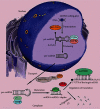A Glance at Biogenesis and Functionality of MicroRNAs and Their Role in the Neuropathogenesis of Parkinson's Disease
- PMID: 37333462
- PMCID: PMC10270766
- DOI: 10.1155/2023/7759053
A Glance at Biogenesis and Functionality of MicroRNAs and Their Role in the Neuropathogenesis of Parkinson's Disease
Abstract
MicroRNAs (miRNAs) are short, noncoding RNA transcripts. Mammalian miRNA coding sequences are located in introns and exons of genes encoding various proteins. As the central nervous system is the largest source of miRNA transcripts in living organisms, miRNA molecules are an integral part of the regulation of epigenetic activity in physiological and pathological processes. Their activity depends on many proteins that act as processors, transporters, and chaperones. Many variants of Parkinson's disease have been directly linked to specific gene mutations which in pathological conditions are cumulated resulting in the progression of neurogenerative changes. These mutations can often coexist with specific miRNA dysregulation. Dysregulation of different extracellular miRNAs has been confirmed in many studies on the PD patients. It seems reasonable to conduct further research on the role of miRNAs in the pathogenesis of Parkinson's disease and their potential use in future therapies and diagnosis of the disease. This review presents the current state of knowledge about the biogenesis and functionality of miRNAs in the human genome and their role in the neuropathogenesis of Parkinson's disease (PD)-one of the most common neurodegenerative disorders. The article also describes the process of miRNA formation which can occur in two ways-the canonical and noncanonical one. However, the main focus was on miRNA's use in in vitro and in vivo studies in the context of pathophysiology, diagnosis, and treatment of PD. Some issues, especially those regarding the usefulness of miRNAs in PD's diagnostics and especially its treatment, require further research. More standardization efforts and clinical trials on miRNAs are needed.
Copyright © 2023 Adam Szelągowski and Mariusz Kozakiewicz.
Conflict of interest statement
The authors declare that they have no conflicts of interest.
Figures


Similar articles
-
The Emerging Role of MitomiRs in the Pathophysiology of Human Disease.Adv Exp Med Biol. 2015;888:123-54. doi: 10.1007/978-3-319-22671-2_8. Adv Exp Med Biol. 2015. PMID: 26663182
-
Current Updates on the Role of MicroRNA in the Diagnosis and Treatment of Neurodegenerative Diseases.Curr Gene Ther. 2024;24(2):122-134. doi: 10.2174/0115665232261931231006103234. Curr Gene Ther. 2024. PMID: 37861022 Review.
-
Assessment of the role of non-coding RNAs in the pathophysiology of Parkinson's disease.Eur J Pharmacol. 2021 Apr 5;896:173914. doi: 10.1016/j.ejphar.2021.173914. Epub 2021 Jan 26. Eur J Pharmacol. 2021. PMID: 33508286 Review.
-
Dysregulated microRNAs in neural system: Implication in pathogenesis and biomarker development in Parkinson's disease.Neuroscience. 2017 Dec 4;365:70-82. doi: 10.1016/j.neuroscience.2017.09.033. Epub 2017 Sep 28. Neuroscience. 2017. PMID: 28964753 Review.
-
Role of miRNAs in Neurodegeneration: From Disease Cause to Tools of Biomarker Discovery and Therapeutics.Genes (Basel). 2022 Feb 25;13(3):425. doi: 10.3390/genes13030425. Genes (Basel). 2022. PMID: 35327979 Free PMC article. Review.
Cited by
-
Perspective Strategies for Interventions in Parkinsonism: Remedying the Neglected Role of TPPP.Cells. 2024 Feb 14;13(4):338. doi: 10.3390/cells13040338. Cells. 2024. PMID: 38391951 Free PMC article.
-
Targeting Regulatory Noncoding RNAs in Human Cancer: The State of the Art in Clinical Trials.Pharmaceutics. 2025 Apr 4;17(4):471. doi: 10.3390/pharmaceutics17040471. Pharmaceutics. 2025. PMID: 40284466 Free PMC article. Review.
-
Natural Products Treat Colorectal Cancer by Regulating miRNA.Pharmaceuticals (Basel). 2023 Aug 9;16(8):1122. doi: 10.3390/ph16081122. Pharmaceuticals (Basel). 2023. PMID: 37631037 Free PMC article. Review.
-
Neuronal dysfunction and gene modulation by non-coding RNA in Parkinson's disease and synucleinopathies.Front Cell Neurosci. 2024 Jan 5;17:1328269. doi: 10.3389/fncel.2023.1328269. eCollection 2023. Front Cell Neurosci. 2024. PMID: 38249528 Free PMC article. Review.
References
-
- Nikitina E. G., Urazova L. N., Stegny V. N. MicroRNAs and human cancer. Experimental oncology . 2012;34(1):2–8. - PubMed
Publication types
MeSH terms
Substances
LinkOut - more resources
Full Text Sources
Medical
Research Materials
Miscellaneous

